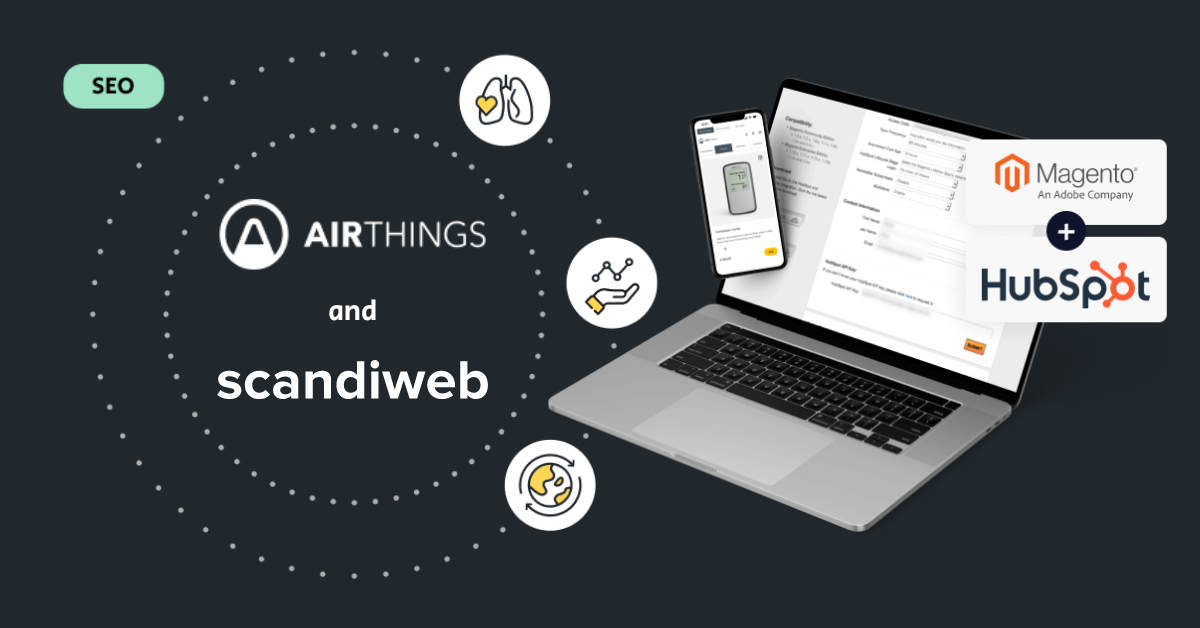
Business overview
Airthings is a global leader in indoor air quality solutions, providing air-quality detection devices to consumers and professionals. Established in Oslo, Norway, in 2008, they now sell worldwide with the mission of educating people on the effects of indoor air contaminants and providing them with accessible technology solutions.
The collaboration between Airthings and scandiweb started in August 2022 when the Airthings team reached out to us for support on a delicate migration. This case study will introduce the factors to consider for a successful website SEO migration on two platforms.
Project overview
From two subdomains on two different platforms (HubSpot and Adobe Commerce/Magento), Airthings wanted to migrate under one unique subdomain keeping two systems. Their goal was to build a modern store that is easier to manage from the backend perspective and better to navigate from a user point-of-view.
Before the migration, Airthings had two subdomains with 12 store views each
- airthings.com informational landings hosted on HubSpot (no shop)
- shop.airthings.com online store on Magento
airthings.com used to be the primary source of traffic. Users used to land on this subdomain for informational content about contaminants, products, and B2B dedicated sections.
shop.airthings.com, on the other hand, only had product detail pages (PDPs), allowing users to complete the purchasing process and proceed to the checkout. PDPs were linked to HubSpot, but they rarely were landing pages; therefore, they received significantly less traffic than airthings.com URLs.
Migration challenges
Merging two subdomains might be challenging and require a fool-proof redirect strategy to avoid losing traffic. However, the real challenge of this case study was managing migration on two platforms.
There are many elements to consider for this kind of migration, but the two most relevant are:
- Ensuring site domain synchronization: since both Magento and HubSpot would be running on
airthings.com, it was necessary to guarantee that the user experience stays onairthings.comwhile surfing both systems - Defining how to apply redirects: given the merge of two subdomains under one, the only plausible option was server-side redirects. However, for this particular migration, server-side redirects were not only used to redirect the old shop.airthings.com URLs to
airthings.combut also to redirect URLs within the same eCommerce platform.
How to execute a migration on two platforms?
Seeing the challenges we had to overcome, a well-defined strategy was crucial to guarantee a successful migration that did not negatively impact organic traffic.
We defined a strategy including the following steps:
- To ensure site domain sync, we implemented a set of proxy rules that defined which subfolders would be hosted by HubSpot and which by Magento. By utilizing HubSpot and Magento search API, we allowed users to pull search results from both platforms while staying on the same domain.
In other words, we defined a list of identifiers for both platforms so that whenever a specific URL was requested, Hubspot and Magento would analyze it and recognize whether it was hosted within their platform.
Here’s an example!
We defined that HubSpot would host every URL under the
/example1/folder, while every URL without a folder would be hosted by Magento. Therefore, when users accesshttps://www.airthings.com/example1/test, they are surfing the HubSpot system, while when accessinghttps://www.airthings.com/test, they are on Magento.
- To ensure correct page redirects, we decided to apply server-side level redirects. As mentioned before, this type of redirect was the only viable option. Still, after explaining our strategy to ensure site domain synchronization, it is easier to understand why they needed to be applied even for redirects within the same eCommerce system.
Let’s illustrate it with an example!
So, every URL under the
/example1/folder is hosted by HubSpot, while every URL without a folder is hosted by Magento. Therefore, if originallyhttps://www.airthings.com/testwas on HubSpot, it would be on Magento after the migration.Let’s hypothesize that we need to redirect
https://www.airthings.com/testtohttps://www.airthings.com/example1/test. This redirect could be applied on HubSpot if both the source and target URLs stay on HubSpot. However, since the source URL will be migrated to Magento, the redirect applied on Hubspot will not work, and users will land on a 404 page. Hence, we must implement a server-side redirect to ensure users will land on the target URL.
Also read: Top 5 Post-Migration Challenges for Magento 2 (Adobe Commerce)
Results
We successfully merged the two subdomains to reach the client’s goal of improving the user experience while navigating the website.
After the migration, we saw +20% of new users from organic search. Additionally, there’s an increase in the average session duration and a decrease in the bounce rate, meaning that it is easier for organic users to navigate and interact with the website, find the information they are looking for and even complete the purchasing process: +5% of transactions completed.
Considering the number of redirects uploaded that affected all the store views and that only a month has passed since the migration, we can consider these results a success!
Airthings website provides a better user experience and now ranks for +10% more keywords in the main markets. In addition, it ranks higher for 15% of the previous keywords. This data shows that pages now have a better score and match to users’ queries.
Are you in the middle of website migration and overwhelmed with SEO issues? Or perhaps you’re planning to migrate to a new platform? Tell us about your project, and we’ll give you a free estimate and ensure successful migration!



Share on: